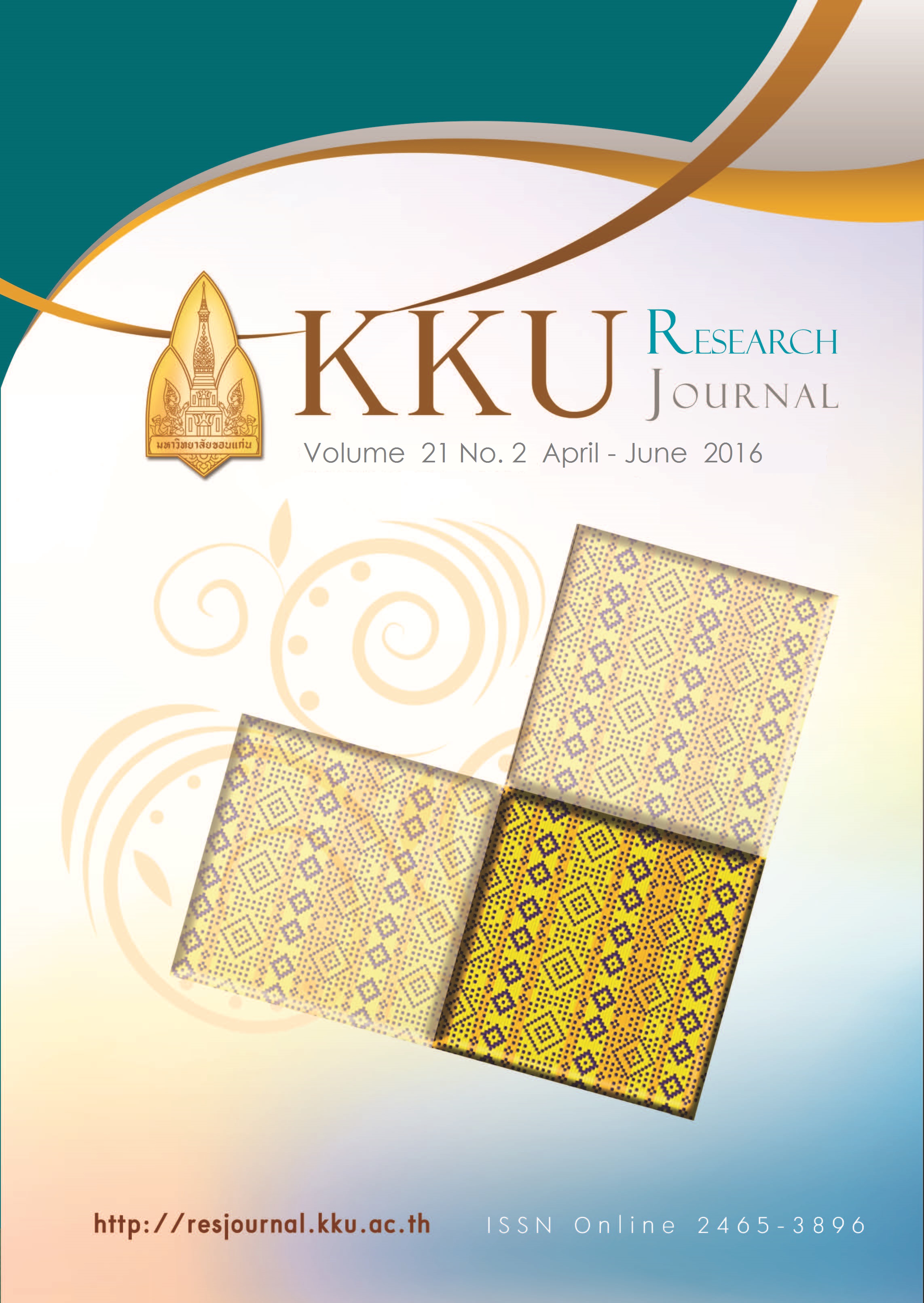The use of Rhizopus sp. mutant for lactic acid production by solid state fermentation
Main Article Content
Abstract
A fungal strain, Rhizopus sp. C018, is a promising filamentous fungus that produces L-(+)-lactic acid. In this study the wild strain of C018 was used for lactic acid production by solid state fermentation on cassava peel incubated at 30oC. The results showed that the strain could produce 32.4 mg/g of lactic acid at day three. Then, the wild strain of C018 was subjected to mutation by UV radiation and the mutant named UV 333 expressed the highest lactic acid production as 57.6 mg/g analyzed by Reflectometer RQflex® 10 Merck Germany at day three. For further studies, mutation by chemicals will be tested to obtain the maximum amount of lactic acid production.
Article Details
How to Cite
Hayihama, S., & Suwazono, W. (2016). The use of Rhizopus sp. mutant for lactic acid production by solid state fermentation. Asia-Pacific Journal of Science and Technology, 21(2), 52–58. https://doi.org/10.14456/kkurj.2016.25
Section
Research Articles
References
[1] Bapiraju K.V.V.S.N, Sujatha. P, Ellaiah P, and Ramana. T. Mutation induced enhanced biosynthesis of lipase. african journal of biotechnology. 2004;3:618-621.
[2] Cannel E. and Moo-Young M. Solid- state fermentation systems process bio chem. 1980.;15:2–7.
[3] Dimerci, A. and Pometto, A.L. Repeated fed-batch fermentation in biofilm reactors with plastic composite supports for lactic acid production. Applied microbiology and biotechnology. 1995;43 (4):585-589.
[4] Food and agriculture organization of the united nations (FAO). The global cassava development strategy and implementation plan. Proceedings of the validation forum on the global cassava development strategy; 2000 26-28 April; Rome, Italy.
[5] Huang LP, Dong T, Chen JW, Li N. Biotechnological production of lactic acid integrated with fishmeal waste water treatment by Rhizopus oryzae. Bioproc Biosystems Eng 2007;30:135-40.
[6] Maas RH, Bakker RR, Eggink G, Weusthuis RA. Lactic acid production from xylose by the fungus Rhizopus oryzae. Appl Microbiol Biotechnol 2006;72:861–8.
[7] Miller, G.L. Use of dinitrosalicylic acid reagent for determination of reducing sugar. analytical. chemistry 1959. 31(3):426-428.
[8] Oda, Y., K. Saito., H. Yamauchi and M. Mori. lactic acid fermentation of potato pulp by the fungus Rhizopus oryzae. current microbiology. 2002;45:1-4.
[9] Pandey A., Soccol C.R., Mitchell D.A., New developments in solid-state fermentation. I. Bioprocesses and products, Process Biochem. 2000;35(10):1153–1169.
[10] Senthuran A, Senthuran V, Mattiasson B, Kaul R. Lactic acid fermentation in a recycle batch reactor using immobilized Lactobacillus casei. Biotechnol Bioeng 1997;55:841–53.
[11] Thalisa Yuwa-amornpitak and Kannika Chookietwattana. Lactic acid production from cassava starch by thermothelerent Rhizopus microspores LTH 23.Journal of biological science . 2014; 14(4): 284-291.
[12] Tay, A and S. T. Yang. Production of L(+)-lactic acid from glucose and starch using immobilized cells of Rhizopus oryzae in a rotating fibrous bed bioreactor. biotechnol. Bioeng. 2002;80(1):1-12.
[13] VickRoy, T.B. Lactic acid. In H.W. Blanch, S. Drew and D.I.C. Wang (eds.).Comprehensive Biotechnolo- gy. Pergamon Press, Oxford. 1985: 761 – 776.
[14] Yin L, Ruan Q and Fu Y. Strain improvement of Rhizopus oryzae for overproduction of lactic acid by random mutations. Academic J. 2013; 7(23), pp. 2970-2975.
[15] Zhang ZY, Jin B, Kelly JM. Production of lactic acid from renewable materials by Rhizopus fungi. Biochem Eng J 2007;35: 251-63.
[2] Cannel E. and Moo-Young M. Solid- state fermentation systems process bio chem. 1980.;15:2–7.
[3] Dimerci, A. and Pometto, A.L. Repeated fed-batch fermentation in biofilm reactors with plastic composite supports for lactic acid production. Applied microbiology and biotechnology. 1995;43 (4):585-589.
[4] Food and agriculture organization of the united nations (FAO). The global cassava development strategy and implementation plan. Proceedings of the validation forum on the global cassava development strategy; 2000 26-28 April; Rome, Italy.
[5] Huang LP, Dong T, Chen JW, Li N. Biotechnological production of lactic acid integrated with fishmeal waste water treatment by Rhizopus oryzae. Bioproc Biosystems Eng 2007;30:135-40.
[6] Maas RH, Bakker RR, Eggink G, Weusthuis RA. Lactic acid production from xylose by the fungus Rhizopus oryzae. Appl Microbiol Biotechnol 2006;72:861–8.
[7] Miller, G.L. Use of dinitrosalicylic acid reagent for determination of reducing sugar. analytical. chemistry 1959. 31(3):426-428.
[8] Oda, Y., K. Saito., H. Yamauchi and M. Mori. lactic acid fermentation of potato pulp by the fungus Rhizopus oryzae. current microbiology. 2002;45:1-4.
[9] Pandey A., Soccol C.R., Mitchell D.A., New developments in solid-state fermentation. I. Bioprocesses and products, Process Biochem. 2000;35(10):1153–1169.
[10] Senthuran A, Senthuran V, Mattiasson B, Kaul R. Lactic acid fermentation in a recycle batch reactor using immobilized Lactobacillus casei. Biotechnol Bioeng 1997;55:841–53.
[11] Thalisa Yuwa-amornpitak and Kannika Chookietwattana. Lactic acid production from cassava starch by thermothelerent Rhizopus microspores LTH 23.Journal of biological science . 2014; 14(4): 284-291.
[12] Tay, A and S. T. Yang. Production of L(+)-lactic acid from glucose and starch using immobilized cells of Rhizopus oryzae in a rotating fibrous bed bioreactor. biotechnol. Bioeng. 2002;80(1):1-12.
[13] VickRoy, T.B. Lactic acid. In H.W. Blanch, S. Drew and D.I.C. Wang (eds.).Comprehensive Biotechnolo- gy. Pergamon Press, Oxford. 1985: 761 – 776.
[14] Yin L, Ruan Q and Fu Y. Strain improvement of Rhizopus oryzae for overproduction of lactic acid by random mutations. Academic J. 2013; 7(23), pp. 2970-2975.
[15] Zhang ZY, Jin B, Kelly JM. Production of lactic acid from renewable materials by Rhizopus fungi. Biochem Eng J 2007;35: 251-63.


